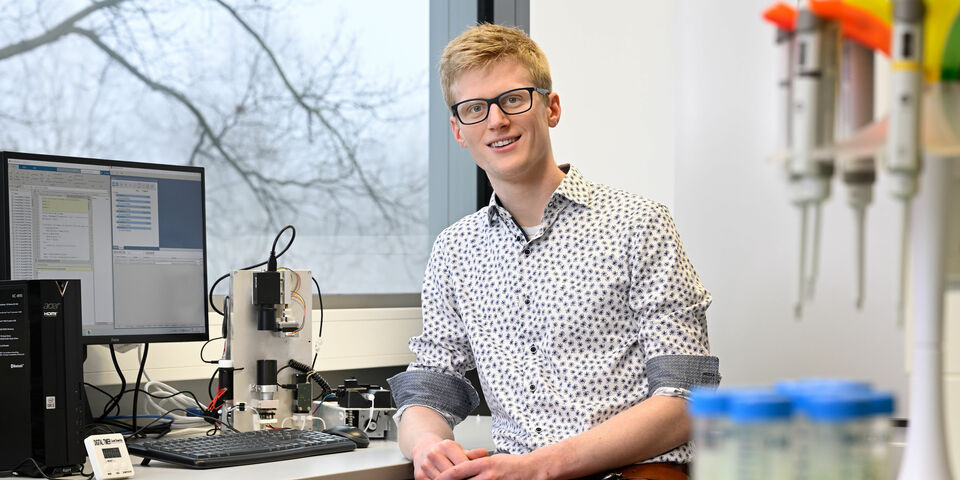Home Stretch | Testing day and night an option with pocket lab
A mini-laboratory in a box. Peering down to see whether or not a second band of color appears; it's become routine, use of the corona self-test. According to Rafiq Lubken, doctoral candidate at the Molecular Biosensing group, a new generation of biosensors is at hand, ready to tailor medical care to the individual patient. It will soon be possible to carry out testing using a sensor not once, but continuously, even for very low concentrations. On Friday January 14th, Lubken will defend his research at the department of BMT.
Taking the corona self-test as an example - who hasn't twirled a swab in their nose, dripped liquid onto the test strip and waited impatiently until the result can be read - Rafiq Lubken explains what exactly a biosensor is. “When you are infected with coronavirus, tiny pieces of virus protein lodge themselves in your throat and/or nasal mucous. When you self-test, you're checking whether those virus proteins are picked up by the test swab. Molecular recognition is going on inside the sensor - the virus is flagged up, as it were - which results in a visible band.”
At the heart of a biosensor, therefore, lies the process of converting this molecular recognition into a measurable signal. Light, electricity, magnetism and movement are among the various ways this can be done. And while we are now seeing biosensors used worldwide to test for coronavirus, their large scale use is nothing new. Diabetes patients have long used a biosensor to monitor their blood sugar levels, tells Lubken. The most commonly used method is the fingertip prick, which produces a droplet of blood for the test strip. For a number of years, however, it has also been possible to continuously monitor blood sugar levels using a sensor lodged under the skin. And thanks to the research of Lubken and his colleagues at the Molecular Biosensing group, the continuous monitoring of many more molecules than just glucose should become possible.
Inflammatory reaction
“Medical science is a huge source of demand. Commercially available continuous biosensors, such as glucose and lactate sensors, measure substances that occur in high concentrations. But, conversely, the substances that physicians find interesting are those present in very low concentrations. Such as inflammatory substances, which provide a good picture of the situation when a patient is experiencing an acute inflammatory reaction. Physicians are keen to track these substances over time in order to estimate the disease progression or to see the effects of a particular treatment. And so we want to make a biosensor with the maximum possible sensitivity, to provide a meter for molecules present in the human body in a low concentration.”
To make just such a biosensor - both continuous and sensitive - Lubken used techniques at the level of a single molecule. This enabled him to separate individual molecules from one another and to determine their concentrations with precision. As the flag, he used a microscopically small particle. In its free state, so he saw under the microscope, this made large movements, but when an individual molecule attached to it, the particle's movements became much smaller, explains Lubken enthusiastically. “It's remarkable how this change in freedom of movement is caused by a single molecular bond.”
Markers
The technology for measuring substances in low concentration with biosensors already exists. It now needs to be established, working in conjunction with physicians and diagnostic researchers, which are the important molecules, the markers as they are called, to measure. “Reducing a disease or bodily process to a couple of markers is a difficult process, and isn't always possible. But the continuous monitoring of molecular concentrations in a patient offers many new possibilities. Every patient is unique and needs unique treatment. Continuous monitoring using biosensors can certainly help bring this about. And we are also looking into how we can expand the use of biosensors. By, for example, introducing the simultaneous measurement of multiple molecules, known as multiplexing. This gives a physician greater insight into the patient's health status.”
It's a lengthy process, developing a new medical sensor and launching it commercially, Lubken is learning in his new role as product and business developer at TU/e spin-off Helia Biomonitoring. “It's a complex world of regulations and requirements. And so we are first working to introduce these biosensors in the food industry. Production processes can be monitored, certain extraction processes optimized; here too the possibilities offered by biosensors are promising. Simultaneously, we can continue to develop sensor technology in this way while also working to bring medical applications closer to realization. We are convinced that in future this little tool will be of considerable value to patients and physicians.”



Discussion